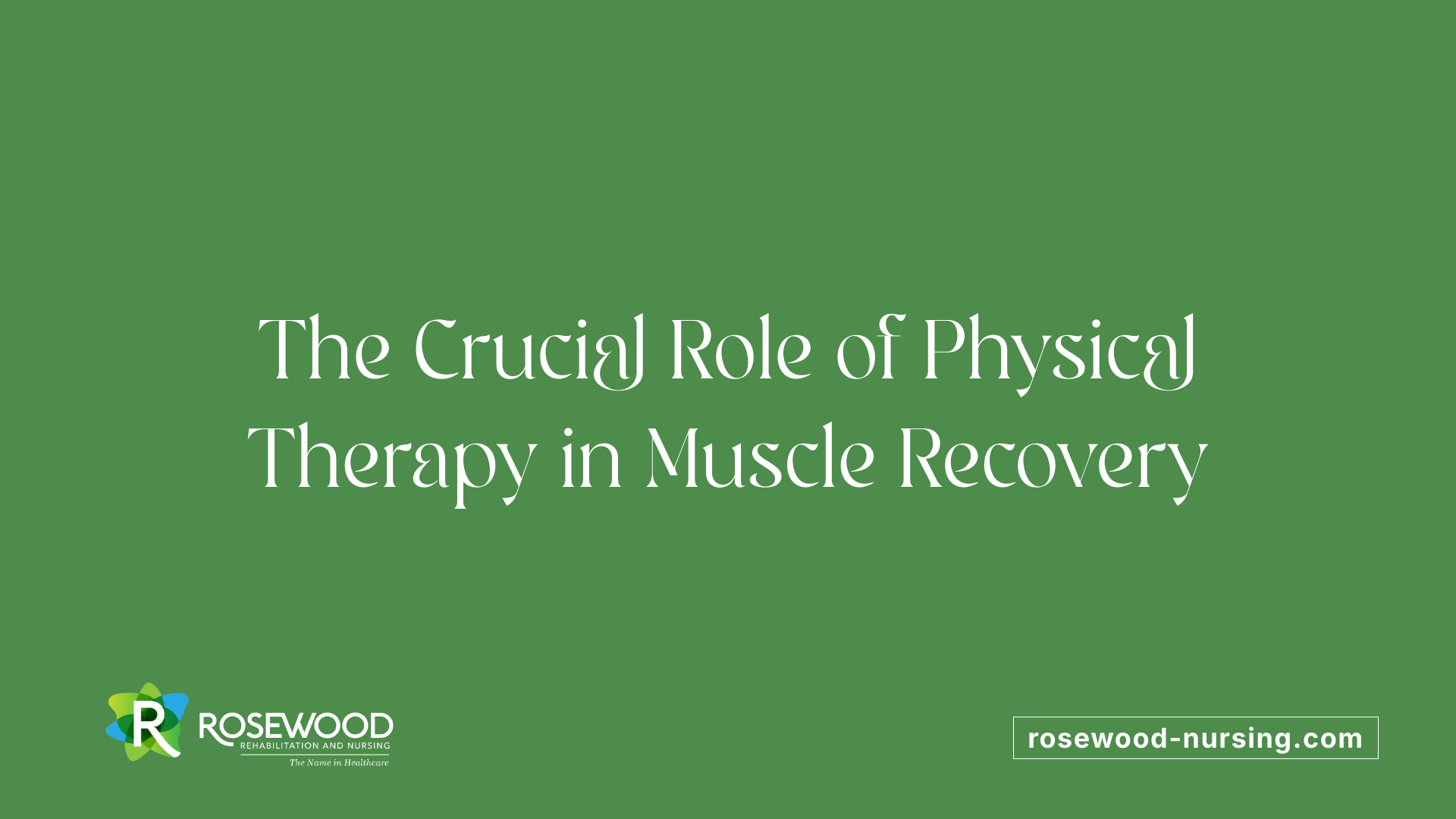How to Strengthen Weak Muscles After Surgery
March 19, 2025
Post-Surgery Recovery: Rebuilding Our Muscles

Understanding Post-Surgery Muscle Weakness
Post-surgery recovery can be a challenging journey, especially when muscle weakness is involved. It is crucial to strengthen weakened muscles to regain full functionality and avoid complications such as atrophy, prolonged weakness, and even blood clots. In this guide, we will delve into the recommended exercises, dietary considerations, and physical therapy approaches that facilitate effective recovery. Understanding how long recovery might take, which strategies to use, and why certain practices are beneficial will empower those recovering from surgery with the knowledge to regain strength effectively.
Why Strengthening Muscles Post-Surgery Matters

Reasons for Muscle Weakness Post-Surgery
After undergoing surgery, leg muscles often weaken due to reduced use during recovery. Immobilization can lead to substantial muscle atrophy, with some studies suggesting that patients may lose up to 10% of muscle tissue every two weeks if inactive. This loss hinders movement and recovery, making it essential to focus on muscle strengthening during rehabilitation.
Importance of Muscle Strengthening
Strengthening the muscles post-surgery is crucial for several reasons. First, it helps restore the strength, flexibility, and endurance lost during the immobility period. Engaging in tailored physical therapy exercises—such as Gluteal Sets and Straight Leg Raises—can rebuild the affected muscles and facilitate better overall recovery. Additionally, muscle contractions aid in pumping blood through veins, significantly lowering the risk of complications such as blood clots and pressure sores.
Post-Surgery Complications Prevention
The importance of moving and exercising after surgery cannot be overstated. Gradual physical activity leads to a marked decrease in complications, as evidenced by studies showing a reduction in complication rates from 52% for bedbound patients to 36% for those encouraged to mobilize. Consistent participation in a structured rehabilitation plan also combats feelings of depression and encourages patients to stay motivated throughout their recovery journey.
How long does it take to regain muscle strength after surgery?
Recovery time for regaining muscle strength after surgery can vary significantly depending on the type of surgery, the individual's health, and their commitment to rehabilitation. Typically, you may not begin physical therapy until around 6 weeks post-surgery. The initial recovery phase focuses on healing, during which strength gains are minimal. It often takes about 4 to 5 months to fully regain muscle strength and return to pre-surgery activity levels, including sports, without pain. However, some individuals may experience a longer recovery, so it’s essential to follow your healthcare provider's guidance throughout the process.
Exercises for Post-Surgery Muscle Strengthening

How can you manage weakness after surgery?
Managing weakness after surgery involves several strategies. Firstly, rest is important, but it should be balanced with light activities recommended by your healthcare team to stimulate circulation and prevent muscle atrophy. Nutrition plays a critical role; ensuring you consume nutrient-rich foods can combat fatigue and support recovery. Furthermore, emotional support and effective pain management cannot be overlooked, as these factors are crucial for a positive recovery experience. Staying hydrated also aids overall health and recovery.
How can you regain muscle mass in the legs after surgery?
Regaining muscle mass in the legs post-surgery can be achieved through targeted exercises. Incorporating exercises like:
- Gluteal Sets: Strengthen buttock muscles without hip movement.
- Heel Slides: Aid in improving knee mobility and strengthen the surgical leg.
- Straight Leg Raises: Target overall leg strength for knee recovery. Working with a physical therapist to create a customized exercise plan is essential, as they can help progress exercises safely. Nutrition is equally important; a protein-rich diet (aiming for 25-30 grams at each meal) supports muscle repair. Gradually increasing exercise intensity through resistance training will further enhance strength during recovery.
| Exercise Type | Purpose | Key Benefits |
|---|---|---|
| Gluteal Sets | Strengthen buttocks | Minimal joint strain |
| Heel Slides | Improve knee mobility | Supports muscle activation |
| Straight Leg Raises | Strengthen entire leg | Essential for knee rehabilitation |
| Quadriceps Strengthening | Rebuild knee function | Enhances control over knee movement |
| Resistance Training | Increase muscle mass | Targets specific muscle groups for growth |
Incorporating these exercises progressively into a rehabilitation routine not only aids in regaining muscle mass but also significantly contributes to preventing post-surgery complications like blood clots and pressure sores.
Role of Physical Therapy in Recovery

What is the role of physical therapy in regaining muscle strength after surgery?
Physical therapy plays a crucial role in regaining muscle strength after surgery by facilitating recovery and promoting rehabilitation. It helps to mitigate muscle atrophy that often occurs post-surgery through targeted exercises and interventions. A skilled physical therapist assesses individual needs and develops a personalized exercise program that focuses on strengthening and rebuilding weakened muscles safely and effectively.
Importance of physical therapy
The importance of physical therapy cannot be overstated, especially after surgical procedures that impact mobility and muscle strength. Engaging in physical therapy shortly after surgery can significantly decrease the risk of complications such as blood clots and pressure sores. Moreover, it fosters early mobility, contributing to quicker recovery times.
Customization in rehabilitation
Customization in rehabilitation is a cornerstone of effective physical therapy. Each individual has unique needs based on their surgical history, age, and overall health. A personalized rehabilitation plan ensures that the right exercises are prescribed, facilitating optimal recovery while considering the patient's comfort and safety.
Techniques used in physical therapy
Physical therapy employs various techniques to support recovery, including:
- Manual therapy: Hands-on techniques to improve movement and relieve pain.
- Electrical stimulation: Helps to activate muscles and assist with pain relief.
- Guidance on movement patterns: Educates patients on proper techniques to prevent injury during exercises.
Overall, the support provided by physical therapy is essential in restoring function and improving the overall quality of life after surgical procedures.
Nutrition for Muscle Recovery

Nutritional needs during recovery
After surgery, the body's need for nutrients increases significantly to support healing. Adequate nutrition is essential as it can influence recovery times and overall outcomes. A well-balanced diet contributes to maintaining muscle mass, regenerating tissue, and enhancing recovery.
Role of specific nutrients
Certain nutrients are vital for muscle repair:
- Protein: Essential for rebuilding muscle tissues. Aim to consume about 1.2 to 2 grams of protein per kilogram of body weight after surgery, with 25-30 grams at each meal being ideal to maximize muscle synthesis.
- Vitamin C: Crucial for collagen synthesis, which helps in the repair of tendons and ligaments. Include foods like strawberries, kiwi, and bell peppers in your diet.
- Calcium and Vitamin D: Important for bone health and muscle contraction. Dairy products are great sources.
- Fiber: Helps alleviate potential constipation from medications post-surgery. Foods like raspberries, dried figs, and oatmeal can be beneficial.
Dietary suggestions for optimal muscle repair
Incorporate foods rich in the above nutrients as part of a varied diet. Here are some strategies:
- Balanced Meals: Combine lean proteins (like chicken, fish, or beans) with whole grains and plenty of vegetables to ensure a wide range of nutrients.
- Hydration: Staying hydrated is just as vital; aim for adequate water intake to support overall bodily functions.
- Supplementation: If needed, consider HMB (beta-hydroxy-beta-methylbutyrate) or creatine supplements to help with muscle recovery and growth.
By focusing on nutrition and gradually reintroducing strength-building exercises, recovery can be more efficient and effective.
Preventing Muscle Atrophy After Surgery

Understanding muscle atrophy
Muscle atrophy occurs when muscle tissue diminishes due to disuse, immobilization, or injury. After surgery, especially involving the lower limbs, patients can quickly lose muscle strength. Studies indicate that muscle atrophy can lead to a 10% reduction in muscle tissue in just two weeks of inactivity. This loss significantly impacts recovery, making it crucial to implement effective strategies to mitigate these effects as soon as possible.
Strategies to prevent atrophy
- Early Mobilization: Engaging in early, gentle movements like ankle pumps and heel slides can enhance circulation and reduce the risk of blood clots while promoting muscle engagement.
- Gradual Exercise Introduction: Start with low-intensity exercises such as seated leg lifts and static quadriceps exercises. These movements can effectively rebuild strength without overexerting weakened muscles.
- Consistency: Regular participation in rehabilitation activities, including physical therapy, is crucial for preventing muscle loss. Performing exercises one to three times a day, as tolerated, can keep muscle activity stimulated and promote recovery.
Importance of early mobilization and exercise
Implementing a regimen of light exercises, such as heel slides and gentle leg extensions soon after surgery, is vital. These not only ward off atrophy but also help in reducing complications like blood clots. Patients are typically encouraged to gradually increase their activity levels, according to their personal comfort and with medical oversight.
In summary, targeted exercises like seated hip flexion, leg extensions, and straightforward movements combined with early mobilization and consistent rehabilitation support are effective strategies in combating muscle atrophy after surgery. For personalized advice on suitable exercises, patients should consult healthcare providers.
Effective Home Exercises for Post-Surgery Recovery
How can you regain leg strength after hospitalization?
Regaining leg strength after hospitalization requires a focus on gradual, tailored exercises. It’s essential to begin with low-impact activities that encourage rebuilding muscle without straining the body.
Recommended Exercises:
- Seated Leg Extensions: Helps with knee mobility.
- Sit-to-Stands: Strengthens quadriceps and improves balance.
- Calf Raises: Targets calf muscles to enhance stability.
- Toe Raises: Builds strength in the lower leg.
- Side Leg Lifts: Engages hip and thigh muscles, important for functional movement.
Aim for at least 30 minutes of moderate exercise daily, totaling about 150 minutes weekly. Don’t forget to include mobility and flexibility exercises, which can often be done in bed, to aid in overall recovery. A physical therapy program can provide further guidance.
How can you strengthen leg muscles at home after surgery?
To effectively strengthen leg muscles at home post-surgery, utilize bodyweight exercises that enhance functional fitness without special equipment. Here are some key exercises to integrate into your routine:
Suggested Home-Based Exercises:
- Bodyweight Squats: Great for building strength in your thighs and glutes.
- Lunges: Engages multiple muscle groups and improves balance.
- Single-Leg Glute Bridges: Targets glutes while stabilizing the core.
- Wall Sits: Strengthens quadriceps and requires no special setup.
- Leg Swings: Enhances flexibility and warms up the lower body.
- Calf Raises: Strengthens calves and promotes proper circulation.
Set a goal of 2 sets of 12 to 15 repetitions for each exercise, progressing the volume as you regain strength. Always incorporate warm-ups and allow for rest days to facilitate recovery. Aim to balance rest with regular activity, paying attention to your body's signals.
Conclusion: A Holistic Approach to Muscle Recovery
Recovering muscle strength after surgery is a multifaceted journey that requires a blend of exercise, physical therapy, nutrition, and patience. By following a personalized rehabilitation program and remaining consistent with recommended exercises and dietary plans, patients can expect to see gradual improvements in their strength and overall physical health. Remember, every recovery process is unique, so it is essential to collaborate closely with healthcare professionals to tailor the practices that best suit individual needs and ensure a safe, effective progression back to health.
References
- The Best Leg Strengthening Exercises After Surgery - Verywell Health
- Regain Strength After Surgery - [P]rehab - The Prehab Guys
- Post-Surgery Deconditioning: Regaining Strength & Mobility
- How to Ease Back into Exercise After Surgery - CORE Orthopedics
- Nutrition for Surgery Recovery - Abbott Nutrition News
- How to Address Post-Surgery Muscle Atrophy - Eastside Ideal Health
- The Best Exercises After Knee Replacement, from a PT - HSS
- How exercise can speed healing after surgery
- Home exercises to improve strength and balance following hospital ...
Similar articles

Exercise Videos For Seniors



The Role of Therapy Services in Preventing Falls in Elderly Residents

The Benefits of Pet Therapy in Long-Term Care Facilities

How to Encourage Participation in Therapy for Long-Term Care Residents
Contact us today and experience ”The Name in Healthcare”
Where compassion, well-being, and a welcoming community converge to redefine your healthcare journey. Welcome to Rosewood, where your family becomes our family.














